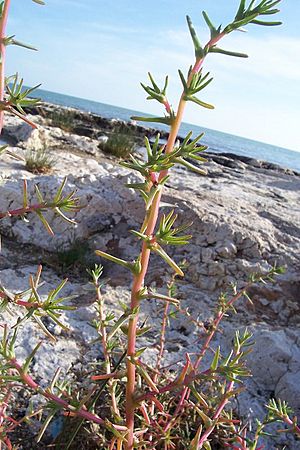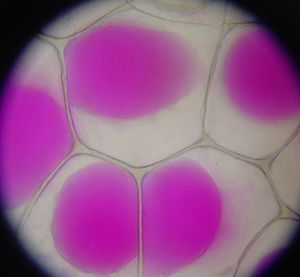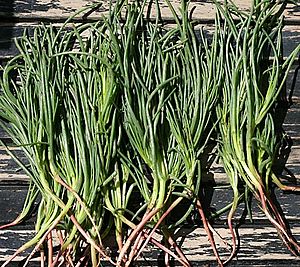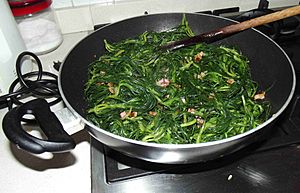Opposite-leaved saltwort facts for kids
Quick facts for kids Opposite-leaved saltwort |
|
|---|---|
 |
|
| Scientific classification | |
| Genus: |
Salsola
|
| Species: |
soda
|
Salsola soda, also known as opposite-leaved saltwort or barilla plant, is a small, bushy plant. It grows up to 0.7 meters (about 2.3 feet) tall. This plant is originally from the areas around the Mediterranean Sea.
Salsola soda is special because it's a halophyte. This means it can grow well in salty soil. It often grows near the coast and can even be watered with salt water.
This plant was once very important in history. People used to burn it to get something called soda ash from its ashes. Soda ash is a key ingredient for making glass and soap. The famous clear glass from Venice in the 1500s was so good because of the pure soda ash used.
In the 1800s, a scientist named Sir Humphry Davy discovered a new element. He found it in a substance related to soda ash and named it "sodium". Before "soda" meant soft drinks, it referred to plants like Salsola soda and the soda ash they produced.
Today, we don't grow Salsola soda for soda ash anymore. But it's still grown as a vegetable, especially in Italy. There, it's called barba di frate or agretti. People say it tastes a bit like spinach, but fresher and livelier.
Contents
What it Looks Like
This plant grows every year and has fleshy, green leaves. It can form small bushes up to 0.7 meters tall. Its stems can be green or red. Tiny flowers grow from the base of the leaves, close to the stem.
Where it Grows
Salsola soda is native to Europe, Asia, and North Africa. It was well-known in Italy, Sicily, and Spain a long time ago. Today, you can also find it along the Atlantic coasts of France and Portugal. It also grows on the Black Sea coast.
The plant has spread to the Pacific coast of North America. Some people worry it might take over natural areas in California's salt marshes. It has also been found growing in South America.
How it Helps Make Soda Ash
When Salsola soda plants are burned, their ashes can be used to make soda ash. Soda ash is a key material for making soda-lime glass, soap, and many other products. The main part of soda ash is sodium carbonate.
For the plant to have a lot of sodium carbonate in its ashes, it needs to grow in very salty soil. This means the plant's tissues will contain a lot of sodium. Salsola soda can even be watered with sea water, which is full of salt. When these salt-rich plants are burned, the sodium in them turns into sodium carbonate.

Most plants, especially food crops, are called "glycophytes." They get damaged if they grow in salty soil because too much sodium is harmful to them. But Salsola soda and other plants grown for soda ash are "halophytes." They can handle much saltier soils. They can also have much more sodium in their tissues than other plants.
Inside the cells of halophytes, there's a special way to deal with sodium. Sodium from the soil can be harmful because it gets in the way of processes that need potassium. Potassium is another important element for plants. Halophyte cells, like those in Salsola soda, have a way to move sodium into a special storage area. This area is called a "vacuole."
A vacuole can take up to 80% of a plant cell's space. Most of the sodium in a halophyte cell can be stored in this vacuole. This leaves the rest of the cell with a safe amount of sodium compared to potassium.
Besides Salsola soda, soda ash was also made from other plants. These included Salsola kali (another saltwort), glasswort plants, and kelp (a type of seaweed). The sodium carbonate from the ashes is dissolved in water. Then, the water is boiled away to get the pure soda ash.
Plants were a very important source of soda ash until the early 1800s. For example, in the 1700s, Spain had a huge industry making "barilla" from saltwort plants. Scotland also had a big industry making soda ash from kelp. This business was so profitable that it led to many people working in "kelping" during the summer.
However, in the early 1800s, a new way to make sodium carbonate was invented. It was called the Leblanc process. This new method used salt, limestone, and sulfuric acid. It was much cheaper and easier. This new process ended the time when people farmed plants just to make soda ash.
Growing and Eating Agretti
The Italian name agretti is often used in English for the edible leaves of Salsola soda. Another common Italian name is barba di frate, meaning "friar's beard."
This plant is not a summer vegetable. It should be planted indoors early or in the autumn. Its seeds are known for not sprouting very well, only about 30 to 40% of them grow. Even though it often grows in salty areas, it can grow without salt water.
Salsola soda is harvested in bunches when it's small. Or, you can regularly cut its leaves to encourage new growth. It's usually boiled and eaten as a leafy green. People suggest cooking it in boiling water until the leaves are soft. It should still have a little crunch, like samphire. You can also eat it raw. It's said to taste "grassy and slightly salty with a pleasant, crunchy texture."
Sometimes, Salsola soda is confused with a Japanese plant called okahijiki. That plant is actually a different species, Salsola komarovii. But the leaves of both plants look similar when harvested.
Special Uses
Scientists have also studied Salsola soda for a special use called bioremediation. This means using living things to clean up the environment. Salsola soda can act as a "biodesalinating companion plant." This means it can help other crops, like tomatoes and peppers, grow better in salty soils.
The Salsola soda plant takes enough sodium out of the soil to help the other crops grow. This leads to better harvests for the main crops. This happens even though both plants are competing for other minerals in the soil.
See also
 In Spanish: Salsola soda para niños
In Spanish: Salsola soda para niños



